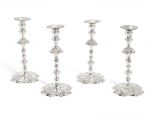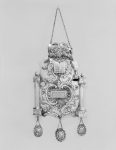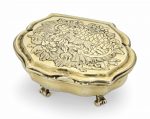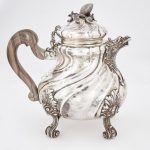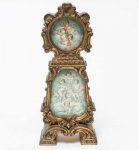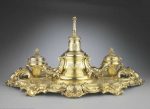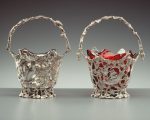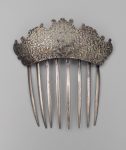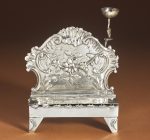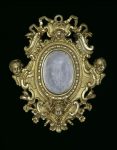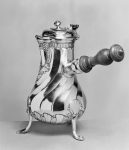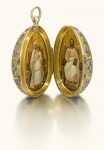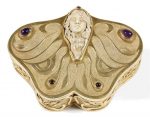The Rococo style of art and design began in France in the early 18th century and was soon introduced to England in the early 1720’s. It followed on from the Baroque style. Rococo designs focused on the carefree aristocratic life and on lighthearted romance. It also revolved heavily around nature.
Rococo in England was considered as the “French taste.” This is now regarded as one of Frances most original and attractive contribution to the Arts. Silverwork, porcelain and silks were strongly influenced by the Rococo Style. Silversmiths embraced the style enthusiastically as it was such a contrast to the plainer elegant style of the Baroque period. Rococo silver is abundant with swirling patterns signifying the flow of water and floral designs and shells. The shell was a common motif and the word Rococo itself is actually a combination of the French word rocaille (shell) and the Italian word Barocco (Baroque Style).
A set of four George II silver candlesticks by William Homer, London 1748 Rococo style, with asymmetrical scroll decoration, removable drip-pans, height 25cm, weight 90oz. (4)
Sold for £ 2,750 inc. premium at Bonhams in 2018
Rococo Style Badge of Anti-Gallican Society; centre: painted enamel of arms of society; St George on horseback spearing flag of Royal Arms of France; escutcheon supported by: dexter, yellow lion; sinister, grey double-headed eagle; blue enamelled scroll with gold motto; top: crown set with rock-crystals, five ship’s sails with cross of St George; base: seated Britannia, painted beneath glass medallion; back: covered by silver-gilt plaques engraved with designs repeated from front; silver suspension loop at back of crown; all surrounded by silver foliate scrollwork set with faceted rock-crystals.
Reference: © The Trustees of the British Museum
Torah Breastplate or Shield, Rococo style, arched panel embossed with leaf scrolls crested by Torah crown, below crown Tablets of Law originally flanked by two bells (one now missing); below Tablets compartment for changeable holiday plaques with plaque engraved plaque in Hebrew that reads, “Yom Kippur,” fluted pillars on sides with engraved flowers and pomegranate finials, three pendant plaques at bottom engraved with Hebrew inscriptions, all indicating names. Condition: Good, one bell missing on left of upper cartouche.
Reference: The Brooklyn Museum
A GERMAN ROCOCO SILVER-GILT SPICE BOX WITH THREE COMPARTMENTS MARK OF JOHANN JAKOB BRUGLOCHER, AUGSBURG, 1751/1753 Cartouche-shaped, on four scroll feet, the cover chased with a leopard and bird on diaperwork ground within a scroll, foliate, floral and rocaille surround, the interior fixed with two dividers 2 5/8 in. (6.7 cm.) wide 2.25 oz. (70 gm.)
Sold for GBP 1,000 at Christie’s in 2015
Italian Sterling Silver Rococo Style Teapot 20th Century Of baluster form, with spiral fluting on four scroll feet with foliate joins, the domed cover with a bud finial. Height 9 inches (23 cm), total approximately 43 ounces, all in.
Sold for $750 (includes buyer’s premium) at Doyle New York in 2018
Portuguese sterling silver-gilt vermeil Rococo miniature enamel putti / winged cherubs and clouds, table / desk clock in the Viennese manner, marked with the early eagle sterling assay mark and maker’s mark, “…rira Marques …rto Lisboa,” circa 1900. 6.25″ H x 2.675″ W x 1.5″ D. Approx 17.76 ozt inclusive.
Sold for $650 at Auctions at Showplace in 2019
Inkstand bearing the arms of Cardinal da Cunha
This large, silver-gilt inkstand was made for export by Thomas Germain, silversmith and sculptor to the king, and bears the arms of Cardinal da Cunha, a member of an eminent Portuguese family. The craftsmanship is consumately skilled and extremely ornate. Entirely chased and decorated with serrated foliage, it is emblematic of the rococo style and of the role played by Thomas Germain in its dissemination.
Reference:The Louvre
Tureen and stand Silversmith: Bernhard Heinrich Weyhe (German, 1702–1782) Date:1769–71
A précis of how the precious metal silver could be transformed into a superior work of art by an artistic and imaginative mind, this tureen is a product of eighteenth-century Augsburg, undisputedly the foremost center of gold- and silversmithing in central Europe at the time. The sophisticated play of textures, daring juxtaposition of plain and lightcatching areas with detailed Rococo decoration, and whimsical sculptural elements reflect the commanding originality of the Augsburg artisans, particularly Bernhard Heinrich Weyhe, the maker of this piece and the leading Augsburg master. The touch of exotic chinoiserie in the pagoda-shaped outline of the tureen’s lid, so en vogue at the time, exemplifies Weyhe’s contributions to the Rococo style, which helped to define its interpretation in southern Germany. His creations are also famous for their highly sculptural finials. On this one, an elegant young woman in hunting costume holds a hooded falcon as a fox howls in the background. Falconry was one of the rare hunting sports that feudal ladies were allowed to participate in. The fox may allude to the contents of the game stew that would have been served in the tureen at hunting banquets, which at the time were lavish court rituals.
Reference: The Metropolitan Museum of Art
Sterling silver basket Made by Walsh & Sons in Melbourne, Victoria, Australia, 1859-1865.
The son of a London silversmith, William Edwards migrated to Melbourne in 1857 to become a leading supplier of silverware -either imported or made in his workshop – initailly from from his premises in Collins Street East, until about 1876. This basket is the earliest object Edwards stamped with his Australian marks and was probably made by him not long after his arrival. This basket is a pair to a very similar piece (with a ruby glass liner) also in this collection, bearing William’s English marks. The English basket, which he must have brought with him, provided inspiration for its Australian pair.
Reference: Museum of Applied Art and Sciences
Comb American Second quarter 19th century
Silver comb; eight teeth, comb top with elaborate rococo design of leaves and small-scale flowers, in two types of silver, design standing out in slight relief.
Reference: Museum of Fine Arts Boston
A German silver Hanukah lamp, maker’s mark AC probably for Albert Caliat, Berlin, circa 1775 shaped rococo cartouche backplate chased with a spray of flowers matched on the lamp cover on four bracket feet probably later, with servant light marked on backplate length 5 in. 12.7 cm
Sold for 4,375 USD at Sothebys in 2018
Frame for a miniature: silver gilt with rococo scrolls and cherubs
This frame, decorated with rococo scrolls and cherubs, may have originally held a miniature portrait or picture. It is small enough to hold in the hand, making it a personal, intimate object rather than part of a grand public display. It may originally have been suspended from a chain or ribbon attached to the suspension loop at the top or perhaps kept in a cabinet.
Reference: © Victoria and Albert Museum
Pots made to serve hot chocolate rather than coffee may be distinguished by a small hole in the lid covered by a sliding or detachable finial. When this hole is uncovered, a swizzle stick can be inserted to stir the hot chocolate and to remove the foam. This pot illustrates the restrained version of the rococo style that remained fashionable in Paris into the late 1770s.
Reference: The Walters Art Museum
